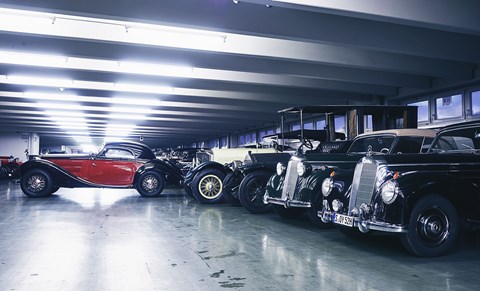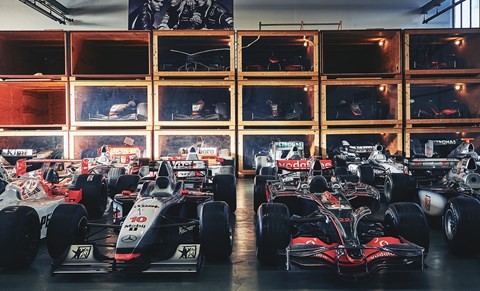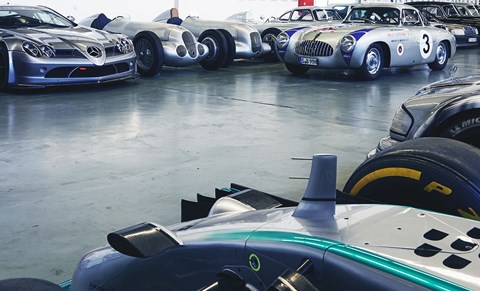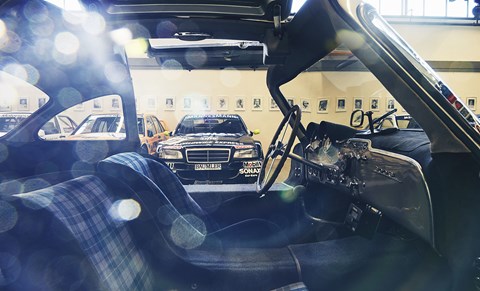► The ‘holy halls’ of Mercedes’ heritage department
► An extraordinary collection recording 129 years of car making
► More than 1000 cars are stashed here, from racers to concepts
The vast roller-shutter door shudders as the electric motor takes up the slack. The noise reverberates around a silent, apparently vast space beyond. The man from Mercedes glances left and right as he holds his thumb to the button, though unless I’m grossly underestimating the bored-looking cat on the other side of the road there’s little here to threaten the secrecy of this most anonymous of industrial buildings.
Slowly, inexorably, the door rises, exposing first an endless gloom and then, well, wonder. The warehouse is aircraft-hanger vast and it is full. The door grinds to a halt and the silence that follows, combined with the bright winter light cascading through the weathered translucent roof, lends the scene a kind of religious luminescence: a Michelangelo in which machines have replaced men.
And what machines. Three C111 prototypes, Mercedes’ metallic orange Futurist wedge, glow like embers in the half-light. Down one wall I spy an entire row of impossibly beautiful 300 and 190 SL coupes and roadsters, the road-going manifestation of Mercedes’ unstoppable 1950s Grand Prix and sports car racers. One’s a fibreglass-bodied one-off – the production cars were bodied in steel or, if you had the means, aluminium. Another, a 190SL with sun-crazed paint and a dash cracked by years in the merciless Texan sun, sports a NASA security sticker in the window, a legacy of America and its astronauts’ obsession with the marque and its most glamorous performance coupe.
Several monolithic Mercedes-Benz 600s bring the bulk, their bellies low to the polished floor on resting hydraulics, ably assisted by an imposing pair of W140 S-class saloons near the door. One, with Schwarzenegger’s name on the logbook, wears California plates and oh-so West Coast chromed Lorinser wheels. Beside it, former chancellor Helmut Kohl’s armoured example sits on run-flat tyres, their sidewalls in a state of perpetual semi-collapse beneath the sheer weight of onboard bulletproofing. And so it goes on. The 2005 Geneva show 320 CDI SLK, complete with triple-turbo diesel V6; a garish yellow W111 saloon with a fibreglass bull on the roof.

And this is just one of the so-called Holy Halls, the network of rarely seen storage spaces in which Mercedes houses cars from its collection that aren’t either on an event, on loan or in the public museum. The company’s been stashing important concept, race and record cars for over a century, and striving to keep safe at least one example of every series production car it’s ever sold. And this is where they live: packed together in a silent record of decades of economic boom and bust, racing glory and tragedy, and world-leading design and engineering, fussed over by men for whom the world begins and ends with the three-pointed star.
As I teeter in an awestruck daze, Michael Bock, 34 years a Mercedes man, until recently head of Classic and a 15-year veteran of motorsport marketing (the F1 safety car relationship is but one of his legacies) delivers the knockout blow. We leave the warehouse, head past the workshops in which cars from the collection are serviced and restored alongside customer Mercedes (cars are rotated in and out of the Halls in more than 1000 movements a year), meander down sunny streets and finally pass through another unmarked door set in another anonymous rendered wall. Reception is small and sparsely furnished. The only clue to what lies beyond is some abstract chequered flag wall-art near the toilet door. There is no noise but the low hum of air-conditioning and a very clever alarm.
Moments later my eyes are adjusting to another vast space, one bookended by a W196 Grand Prix car at one end and, at the other, a collection of some 30 more recent Formula One cars: Petronas Silver Arrows and Mercedes-powered Vodafone McLarens, half of them stacked in bespoke clear-fronted wooden cells like the mother of all Matchbox car collections. Between them, ranks of racing Mercedes of every conceivable type, from Group C Saubers to DTM 190Es, aero-engined speed record survivors to a 450SLC rally car without a single un-marked panel, the car Hannu Mikkola and co-driver Arne Hertz urged to victory in the 1979 Rallye Côte d’Ivoire. It has never been washed. The African dust is 36 years old. Around the corner, somewhat incongruously, sits an electric A-class prototype with its keys on the windscreen wipers, perhaps in the hope that someone helps themselves.
Around the walls and mounted in identical frames at head height, some 250 black and white portraits of Mercedes drivers past and present. ‘The cars are fantastic of course, but racing and winning is as much about the people,’ says Bock. They’re all here: Moss, Fangio, Kling, Hamilton, Hakkinen, Mass, Montoya, Ludwig, Stuck, Schumacher, Frentzen, Schneider, Wendlinger. And between them, with moustaches and flat caps, men from motor racing’s frontier years, men like Belgian ace Camille Jenatzy, ‘The Red Devil’, who died not in a crash but in a bizarre hunting accident, mistaken for a boar.

Again it’s these contrasts that prove most fascinating: little vignettes thrown up by the Halls’ disarmingly eclectic cheek-by-jowl approach to storage. A Roland Asch DTM 190E Evolution II, in Camel livery with an ‘AMG of South Africa’ sunstrip, sits with a later C-class-based racer, an approximation of the W202 production car’s shape just discernible beneath distended arches, jutting splitters and vast wings. Only a few years separate them, yet technically they’re worlds apart, reflecting the engineering arms race that erupted when the German touring car championship relaxed its technical regulations for 1993.
‘The 190E is close to a production car,‘ explains Bock. ‘Easy for us to look after now, and to run at events. But the rules changed, Alfa Romeo came in and won with a four-wheel-drive V6 155, and so Mercedes came back with the C-class: anti-lock brakes, a V6 engine made by taking two cylinders from the 4.2-litre production V8 and, later, pneumatic valves. Power was 400bhp, 500bhp by 1996. They also used a sliding weight system in the floor, to help against the four-wheel-drive Alfa Romeos and Opels. The weight slid forward under braking, for more grip at the front, and then backwards at the exit for traction.
Also, because there were two races on the Sunday just 20 minutes apart, the engine could be changed in ten minutes. A few fasteners, some quick-release hoses and then you swapped the whole front: engine, suspension, everything. Amazing cars but so sophisticated, so expensive – we could not start this one for you easily. It’s the same with the Formula One cars. You need special software for the engine, the gearbox. For this reason we prefer the older cars!’
And what older cars they are. No sooner are you through the door than you’re greeted by the unique, irreplaceable, almost mythical Uhlenhaut coupe. The personal steed of ace Mercedes designer and engineer Rudolf Uhlenhaut, the coupe was snatched from oblivion as the works racing programme was shut down in the mid-1950s, just as his team was working on a SLR/SL hybrid based on the all-conquering W196 Grand Prix car. The coupe was put on the road as Uhlenhaut’s own 260bhp, 180mph company car.
Close by, Carraciola’s 268mph Rekordwagen nears the end of a two-year restoration, a sleek, four-wheeled teardrop of a car wearing replica bodywork. The original body rests in a room off the main hall, its ultra-thin duralumin skin planished and perforated by the ravages of time. On stands it floats ethereally in the gloom, a touchstone to a different time, a different world.

And because in the Holy Halls everything, even the Rekordwagen, is almost immediately upstaged by the next car you see, the bar is raised moments later by a curious looking chassis, pinned against a wall by historically significant ephemera. Six vast hubs on three axles give the thing the appearance of a dilapidated railway locomotive. Then your eyes pick out a solitary driver’s seat in the gloom, dwarfed by a vast drum-like transmission casting that sits atop the frame rails like Hussein’s supergun. It must, you surmise, have been designed to take a very big engine, something like a 3000bhp 44.5-litre Daimler Benz V12 perhaps. ‘The T80 was a product of the speed record wars of the 1930s,’ explains Bock. ‘Hans Stuck – the old one – was the driving force behind trying to win the record back from Auto Union, and he convinced Mercedes to build the T80. The target was 600kph (373mph), but the war broke out before the car could run.’
It’s a menacing creation and, at eight metres long and more than two and a half tonnes, an awesome testament to the power of technical ambition given free reign by an almost limitless budget. The T80 was to use an enlarged version of the engine Daimler would supply for the Messerschmitt Bf109 fighter, and at this time engineering expertise flowed freely between the automotive and aeronautical worlds.
‘The record cars, they are just like aircraft in their construction, and the T80 engine was magnificent,’ continues Bock. ‘The original was lost during the war, so we bought this Messerschmitt engine. It was always my plan to rebuild this car. I hope my successor feels the same. (After we meet, Bock is set to leave his position with Classic to focus on a role in sport and lifestyle marketing). We probably couldn’t run the T80 but just imagine just starting it up at the Goodwood Festival of Speed! That thunder, it would be quite something. Cars on display, silent, are one thing, but to have them moving, alive, with the noise, that is when they are really powerful.’
We move on, past 300SLRs, past a modern SLS 24 hour winner streaked in rubber, past a W165, the 1.5-litre supercharged V8 one-off built to win a single race, the 1939 Tripoli Grand Prix, past a W25 Grand Prix car and past a W125, the altogether more surefooted racer Uhlenhaut, then only a young man and a graduate of Mercedes’ production car test team, evolved the W25 into during countless laps of the fearsome Nordschleife.

I can’t help but stop at a Sauber C9, for many the ultimate expression of the timeless Group C silhouette and a fearsome race machine: the C9 won the 1989 24 Hour of Le Mans and every other race that season bar one. ‘These Saubers were such great cars, just beautiful,’ agrees Bock. ‘The engine, the turbocharged V8, came out of the C111 programme, and this is one of the reasons I say that the C111 was the beginning of modern Mercedes-Benz. With those prototypes they tested so many things, so many engines and ideas on aerodynamics.
‘When the C111 project finished the turbo V8 was kept alive by a passionate team working out of hours, and the engine was raced first in the C7. This was a Sauber with Mercedes support, but when it was clear the car and the engine were good, in 1989, Mercedes said, ‘Ok, now we paint the car silver and we put the three-pointed star on the front. I have not driven this car but I have been a passenger, at Le Castellet. It was an education. The problem is finding the right drivers – we are running out of heroes.’
A Hamilton McLaren MP4-23, apparently wrought entirely in fins, wings, turning vanes and chimneys, the invisible movement of a 200mph airstream rendered visible in exquisitely slim carbonfibre, sits in stark contrast to a later Rosberg car conceived after a radical shake-up of the F1 aero rulebook for 2009. Further down the row a 1999 Hakkinen McLaren MP4-14, the 3.0-litre V10 under its engine cover gazing upon the lowlier V8s and hybrid V6s with disdain. Beside it sits a collection of faded blue shipping crates. On one, the legend ‘DBUT’ and a three-pointed star: Daimler Benz Untertürkheim, the location – then and now – of the factory. On the side, a faded note paints a vivid picture with few words: ‘Amsterdam to Buenos Aires, 13th December 1954, Alfred Neubauer’. Inside, the Silver Arrows team boss’s personal race kit; pit boards, name plates and flags to communicate with his drivers in a time before onboard radios.
Time’s up. As Bock and I head for the door we’re stopped by a single word: Senna. ‘The 190E he drove in a one-make race to celebrate the opening of the new Nürburgring in 1984. He wasn’t well known back then but he won.’ I suggest that the association makes this 190E a pretty valuable car. ‘Yes, but we have one or two of those in here,’ smiles Bock.
